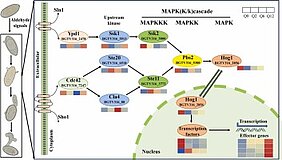C28-aldehyde (n-octacosanal) modulates stage-specific temporal expression of effector genes in the wheat powdery mildew fungus
01.12.2025C28-aldehyde (n-octacosanal) modulates stage-specific temporal expression of effector genes in the wheat powdery mildew fungus
Mo Zhu, Wanwan Zhang, Fuhai Zhang, Xiao Duan, Zongbo Qiu, Sujing Zhao, Shiqiang Gao, Fei He (2025)
Microbiological Research 301 (2025) 128311
The prepenetration processes of the wheat powdery mildew fungus, Blumeria graminisf. sp. tritici (Bgt), are triggered by C28 aldehyde (n-octacosanal), a component of cuticular waxes. Despite being the most severe crop disease worldwide, the underlying molecular mechanisms of the prepenetration processes remain obscure. Utilizing a Formvar®-based in vitro system, transcriptomes of Bgt conidia impacted by n-octacosanal were profiled without the effects from plant host. A total of 1354 differentially expressed genes were identified between n-octacosanal- and n-octacosane (non-chemical signal)-treated conidia. The expression of effectors, transcription factors, and HOG-MAPK pathways is specifically regulated by n-octacosanal in a developmental stage-dependent manner. Among them, 25 effectors and three transcription factors, including COD 1, VEA, and CreA, were highly expressed at all stages. While some genes of the HOG-MAPK pathway were significantly upregulated during conidial growth, other genes were downregulated. These results revealed that C28 aldehyde-triggered Bgt conidial prepenetration in the plant host might be achieved by activating specific transcription factors and differentially regulating the HOG-MAPK pathway. The genes detected by our gene expression analysis may be crucial for successful infection by Bgt and thus serve as candidates for future functional analysis of the molecular mechanisms of conidia development in powdery mildew. These findings provide new insights into the chemical-signal-orchestrated development of an important phytopathogenic fungus and will potentially support efforts for the control and management of fungal diseases in wheat.


